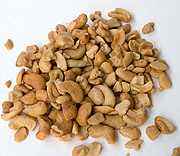Cashew Nuts Nutrition Facts

The cashew tree produces cashew nuts, which is native to the northeast coast of Brazil. The tree bears a pear-shaped "false" fruit, known in Brazil as Caju, meaning "the fruit". It is also called the cashew apple, and is typically yellow or red.
The Caju grows just behind what appears to be the fruit of the cashew and is a swollen peduncle that yields the cashew nut. The actual cashew nut is a kidney-shaped drupe that grows at the end of the cashew fruit.
Inside the nut kernel you will find a layer of thick liquid between the shell and nut. This oil is known as cardol and is toxic if eaten. Therefore, cashew nuts must be cleaned and roasted or boiled to remove the toxins and in order to make it safe and edible.
Although cashew nuts may have originated from Brazil, the Portuguese spread this plant and it is now cultivated in areas with a warm and humid climate. In 2005, the top raw cashew producing country was Vietnam, followed by India, Brazil and Nigeria.
Cashew nuts are commonly used in Asian cuisine and although mainly eaten in their full, nut form, may still be crushed to form butter similar to peanut butter.
100g of dry, roasted nuts without any added salt will give the body 574 calories, a fat content of 46 grams, 33 grams of carbohydrates, 15 grams of protein and about 16 milligrams of sodium.
Like all nuts, cashew nuts are an excellent source of fiber and protein. They contain potassium, magnesium, phosphorus, selenium, copper and B vitamins.
Due to their high fat content, it is advisable to not consume more than two to three servings of cashew nuts per week.
Author: Dimi Ingle.
Copyright: Remedium. This article may not be copied, in whole or in part, without the written consent of Remedium.
|